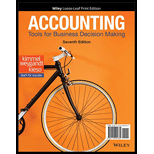
(a)
Indicate the periodicity assumption affecting the accounting transaction.
(a)
Explanation of Solution
Periodicity assumption: The activities of the business which can be divided into different periods like month, quarter, or a year by the accountant, is known as periodicity assumption.
Fiscal year: The fiscal year refers to the accounting period of 1 year, which may not be the usual calendar year (starts from January.1 to December.31), used by the business entities for accounting purpose. This fiscal year varies differently for different countries.
Accounting transaction: An accounting transaction is a business event which has a monetary value that creates an impact on the financial statement of the business.
The periodicity assumption refers to the recognition of all accounting transactions occurred during a specific accounting period. The specific accounting period may be for a month, quarter, half-year, or a year, as chosen by the accountant of the business for analysis, and recording.
(b)
Explain the fiscal year.
(b)
Explanation of Solution
The fiscal year refers to the accounting period of 1 year which may not be the usual calendar year (starts from January.1 to December.31), used by the business entities for the purpose of controlling, budgeting, accounting, and reporting. This fiscal year varies differently for different countries.
Want to see more full solutions like this?
Chapter 4 Solutions
EBK ACCOUNTING:TOOLS F/BUSINESS...
- How much would profit increase.arrow_forwardLast year, you purchased a stock at a price of $48.00 per share. Over the course of the year, you received $2.40 in dividends and inflation averaged 2.8 percent. Today, you sold your shares for $52.20 per share. What is your approximate real rate of return on this investment?arrow_forwardHello tutor please provide correct answer this general accounting question and given step by step explanationarrow_forward
- The incremental net income formarrow_forwardEliza had a commercial warehouse destroyed in a hurricane. The old warehouse was purchased for $310,000, and $94,000 of depreciation deductions had been taken. Eliza received insurance proceeds of $610,000. Although the new warehouse was larger and more modern than the old one, it qualified as replacement property. Eliza acquired the new property 11 months after the hurricane for $660,000. What is the amount of Eliza's realized gain, recognized gain, and the basis in the new property? Answerarrow_forwardMeadowlane Furnishings had a beginning inventory of $105,000, an ending inventory of $147,000, a cost of goods sold of $325,000, and a sales revenue of $510,000. What is Meadowlane’s days in inventory?arrow_forward
- Help me with thisarrow_forwardDetermine the accounts receivable average collection periodarrow_forwardLucid Echo Studios has forecasted sales of $24,000,000 for next year and expects its cost of goods sold (COGS) to remain at 75% of sales. Currently, the firm holds $2,700,000 in inventories, $1,800,000 in accounts receivable, and $2,200,000 in accounts payable. What is the length of Lucid Echo Studios' cash conversion cycle (CCC)? a. 40.94 days b. 31.58 days c. 37.53 days d. 43.75 daysarrow_forward

 AccountingAccountingISBN:9781337272094Author:WARREN, Carl S., Reeve, James M., Duchac, Jonathan E.Publisher:Cengage Learning,
AccountingAccountingISBN:9781337272094Author:WARREN, Carl S., Reeve, James M., Duchac, Jonathan E.Publisher:Cengage Learning, Accounting Information SystemsAccountingISBN:9781337619202Author:Hall, James A.Publisher:Cengage Learning,
Accounting Information SystemsAccountingISBN:9781337619202Author:Hall, James A.Publisher:Cengage Learning, Horngren's Cost Accounting: A Managerial Emphasis...AccountingISBN:9780134475585Author:Srikant M. Datar, Madhav V. RajanPublisher:PEARSON
Horngren's Cost Accounting: A Managerial Emphasis...AccountingISBN:9780134475585Author:Srikant M. Datar, Madhav V. RajanPublisher:PEARSON Intermediate AccountingAccountingISBN:9781259722660Author:J. David Spiceland, Mark W. Nelson, Wayne M ThomasPublisher:McGraw-Hill Education
Intermediate AccountingAccountingISBN:9781259722660Author:J. David Spiceland, Mark W. Nelson, Wayne M ThomasPublisher:McGraw-Hill Education Financial and Managerial AccountingAccountingISBN:9781259726705Author:John J Wild, Ken W. Shaw, Barbara Chiappetta Fundamental Accounting PrinciplesPublisher:McGraw-Hill Education
Financial and Managerial AccountingAccountingISBN:9781259726705Author:John J Wild, Ken W. Shaw, Barbara Chiappetta Fundamental Accounting PrinciplesPublisher:McGraw-Hill Education





